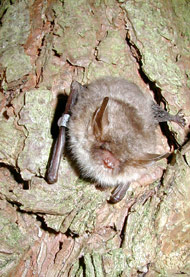Bats also enjoy legal protection in the UK through the Wildlife and Countryside Act 1981 (as amended), the Wildlife ( Northern Ireland) Order 1985 and on the Isle of Man by the Wildlife Act 1990. Further protection is provided by the Conservation (Natural Habitats, &c.) Regulations 1994, the equivalents, in Northern Ireland, is the Northern Ireland Regulations 1995, these are commonly referred to as the Habitats Regs.
In 2001 the Countryside and Rights of Way (CRoW) Act 2000 came into force, in England and Wales, and included amendments to the Wildlife and Countryside Act. These strengthen the protection for species within the Schedules 1 & 5 of the Act, while equivalent legislation is under consideration in Scotland, at the time of writing no alternative protection is available in Northern Ireland.
The most influential amendment made by the CRoW Act was the introduction of the word ‘reckless’ to the offences of disturbance, destruction of obstruction of a bat or it’s roost site, whether occupied or not. The current legal definition of ‘reckless’ is derived from R v Caldwell (1982). This stated that the prosecution have to show one of two options;
- that a person deliberately took an unacceptable risk (recognised the risk but took it anyway) or,
- that they failed to notice or consider an obvious risk (did not consider whether there was a risk)
….and as a result of this disturbance, destruction or obstruction etc. occurred.
The term ‘reckless’ does not apply to a person who makes a genuine error of judgement; for example a person may make an honest assessment of the risk, and conclude that in their opinion there is no risk, even though their interpretation is wrong.
The introduction of the CRoW Act, meant that; considering the potential any natural or manmade structure, or landscape feature has to contain a bat roost, or form part of essential foraging areas around a roost, has become an important part of all pre-work job assessments. When thinking about a planning application the possible presence of a protected species like bats is a material consideration of the planning process and dealt with within the Planning Policy Guidance Note (PPG9)
The Habitats Regulations provided protection not only for the bat and it’s roost site (whether occupied or not), they also cover the habitat used by bats both for roosting and foraging. Where bats are concerned this could also included the flight lines they use between favoured roost sites and good foraging areas. This becomes an essential consideration when there is a proposal to reduce or remove an old hedgerow, or where clear felling of woodland is proposed. The preservation of a connective landscape is incredibly important.
More information can be found in the Arboricultural Association Guidance Note - Trees and Bats, written by Andrew Cowan 2004. Download order form here
For more information e-mail: consulting@arborecology.co.uk
Ecology:
Bats +
[ Activity Survey
- Legal Issues - When an Offence
has been committed - Habitats
regulations licenses ] |
